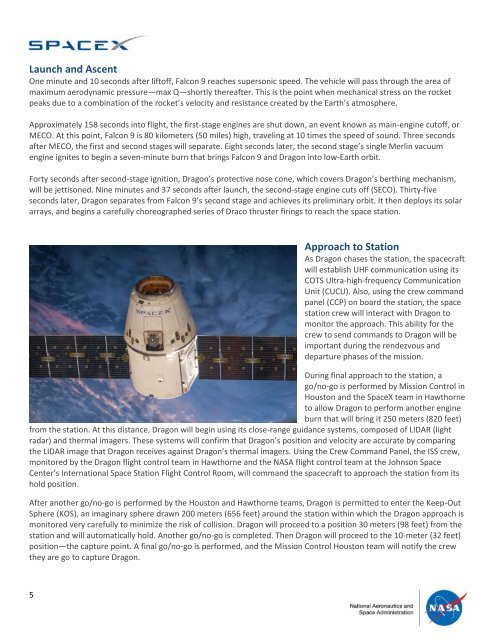spacex_nasa_crs-6_presskit
Create successful ePaper yourself
Turn your PDF publications into a flip-book with our unique Google optimized e-Paper software.
Launch and Ascent<br />
One minute and 10 seconds after liftoff, Falcon 9 reaches supersonic speed. The vehicle will pass through the area of<br />
maximum aerodynamic pressure—max Q—shortly thereafter. This is the point when mechanical stress on the rocket<br />
peaks due to a combination of the rocket’s velocity and resistance created by the Earth’s atmosphere.<br />
Approximately 158 seconds into flight, the first-stage engines are shut down, an event known as main-engine cutoff, or<br />
MECO. At this point, Falcon 9 is 80 kilometers (50 miles) high, traveling at 10 times the speed of sound. Three seconds<br />
after MECO, the first and second stages will separate. Eight seconds later, the second stage’s single Merlin vacuum<br />
engine ignites to begin a seven-minute burn that brings Falcon 9 and Dragon into low-Earth orbit.<br />
Forty seconds after second-stage ignition, Dragon’s protective nose cone, which covers Dragon’s berthing mechanism,<br />
will be jettisoned. Nine minutes and 37 seconds after launch, the second-stage engine cuts off (SECO). Thirty-five<br />
seconds later, Dragon separates from Falcon 9’s second stage and achieves its preliminary orbit. It then deploys its solar<br />
arrays, and begins a carefully choreographed series of Draco thruster firings to reach the space station.<br />
Approach to Station<br />
As Dragon chases the station, the spacecraft<br />
will establish UHF communication using its<br />
COTS Ultra-high-frequency Communication<br />
Unit (CUCU). Also, using the crew command<br />
panel (CCP) on board the station, the space<br />
station crew will interact with Dragon to<br />
monitor the approach. This ability for the<br />
crew to send commands to Dragon will be<br />
important during the rendezvous and<br />
departure phases of the mission.<br />
During final approach to the station, a<br />
go/no-go is performed by Mission Control in<br />
Houston and the SpaceX team in Hawthorne<br />
to allow Dragon to perform another engine<br />
burn that will bring it 250 meters (820 feet)<br />
from the station. At this distance, Dragon will begin using its close-range guidance systems, composed of LIDAR (light<br />
radar) and thermal imagers. These systems will confirm that Dragon’s position and velocity are accurate by comparing<br />
the LIDAR image that Dragon receives against Dragon’s thermal imagers. Using the Crew Command Panel, the ISS crew,<br />
monitored by the Dragon flight control team in Hawthorne and the NASA flight control team at the Johnson Space<br />
Center’s International Space Station Flight Control Room, will command the spacecraft to approach the station from its<br />
hold position.<br />
After another go/no-go is performed by the Houston and Hawthorne teams, Dragon is permitted to enter the Keep-Out<br />
Sphere (KOS), an imaginary sphere drawn 200 meters (656 feet) around the station within which the Dragon approach is<br />
monitored very carefully to minimize the risk of collision. Dragon will proceed to a position 30 meters (98 feet) from the<br />
station and will automatically hold. Another go/no-go is completed. Then Dragon will proceed to the 10-meter (32 feet)<br />
position—the capture point. A final go/no-go is performed, and the Mission Control Houston team will notify the crew<br />
they are go to capture Dragon.<br />
5


